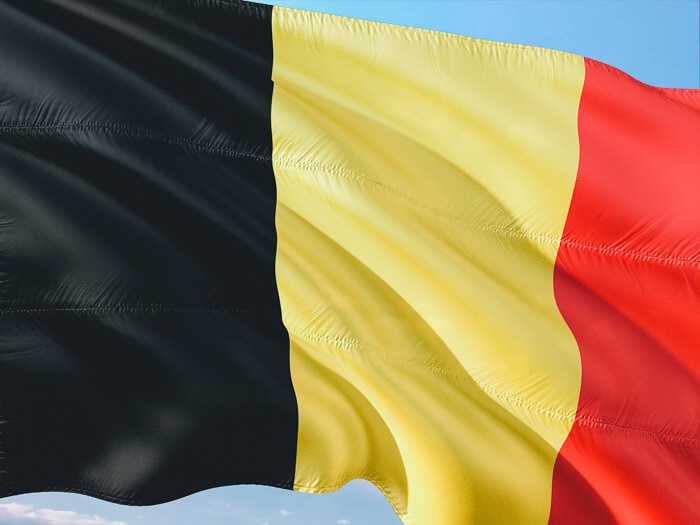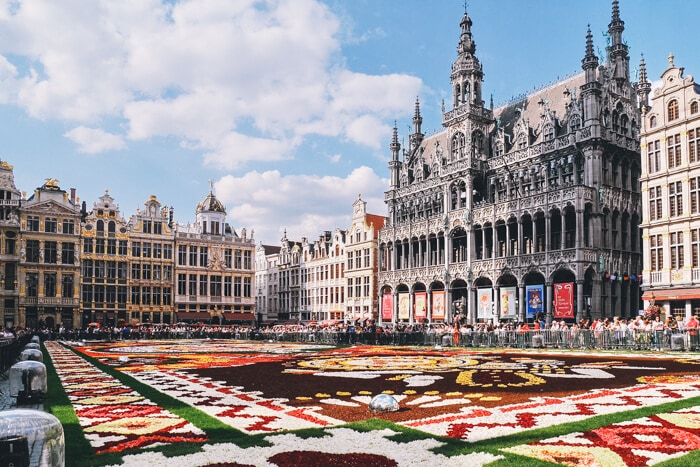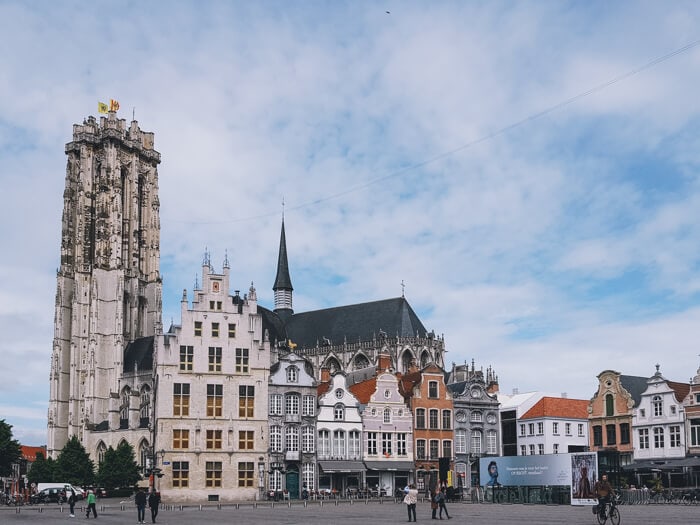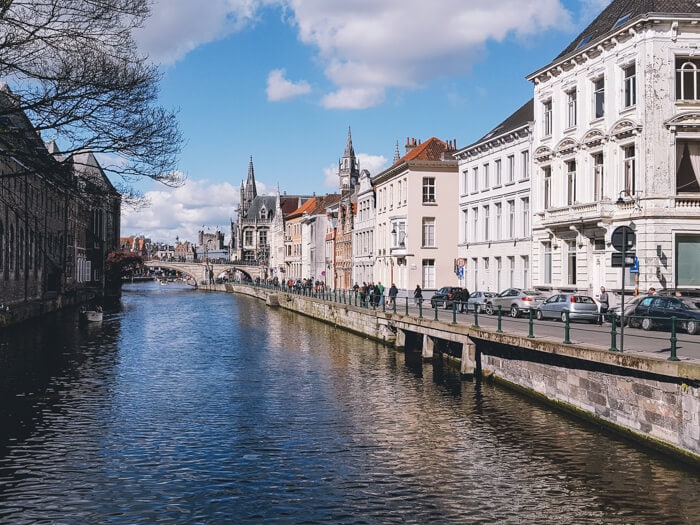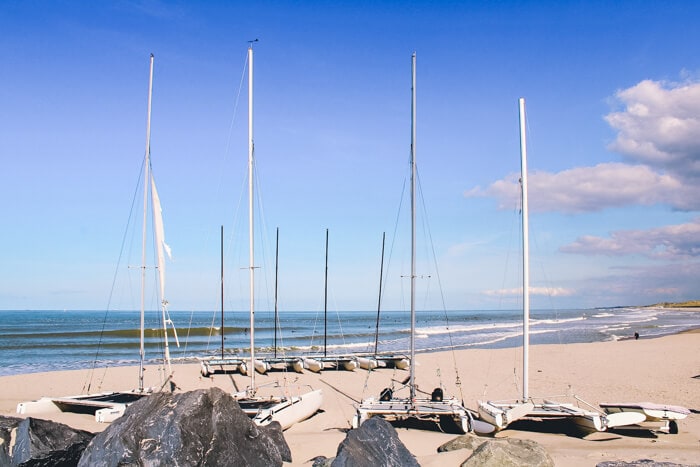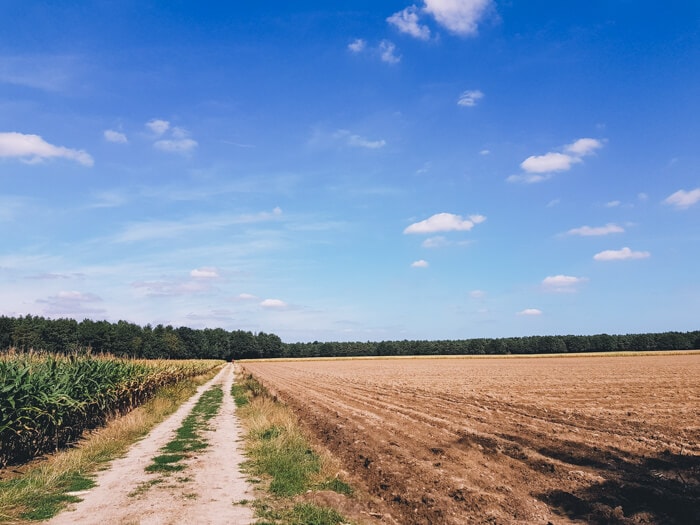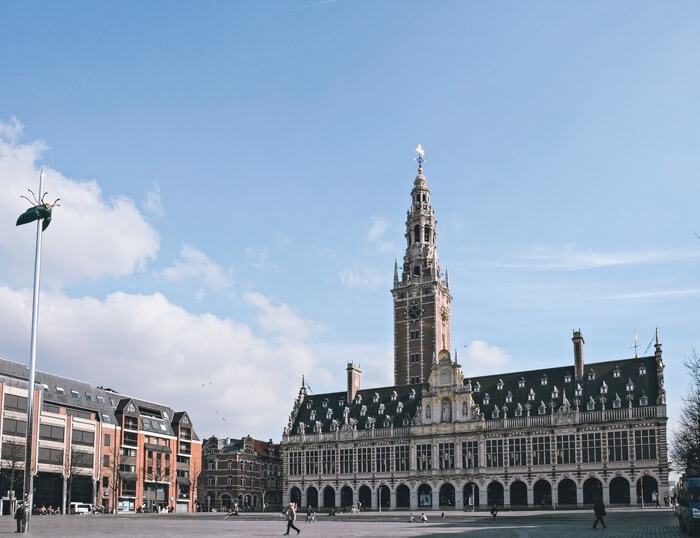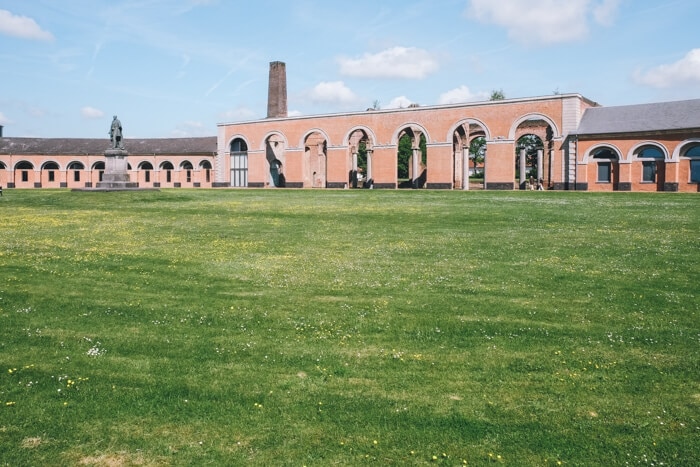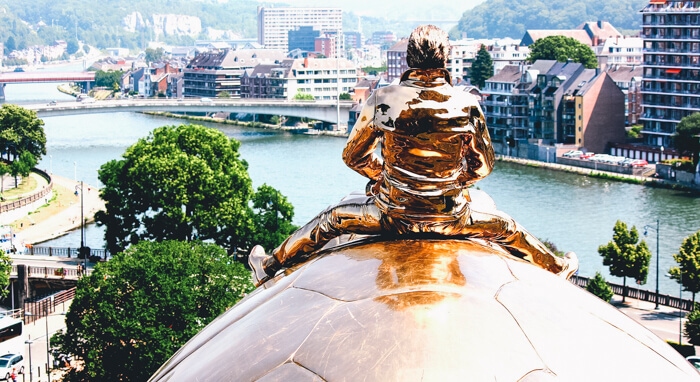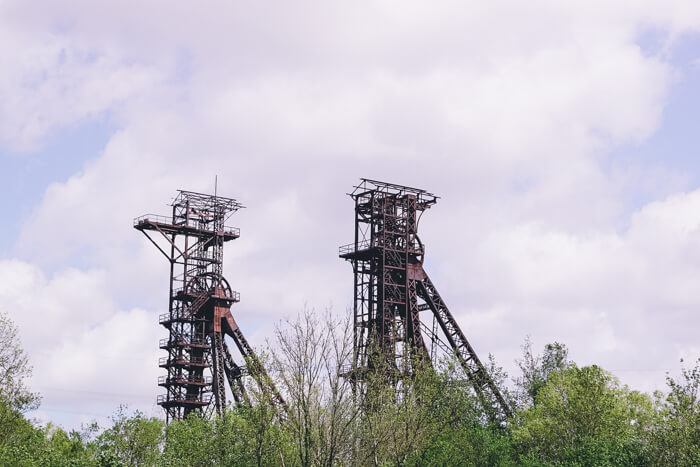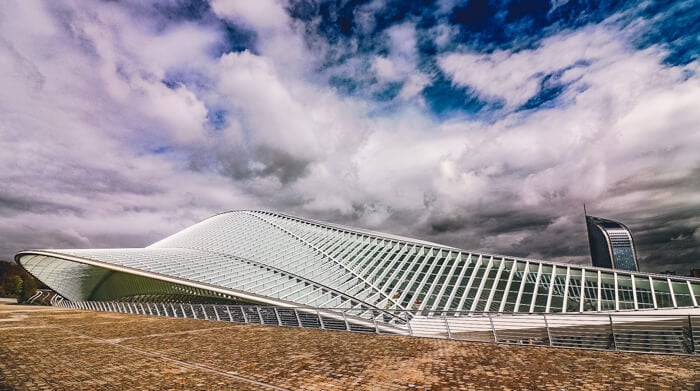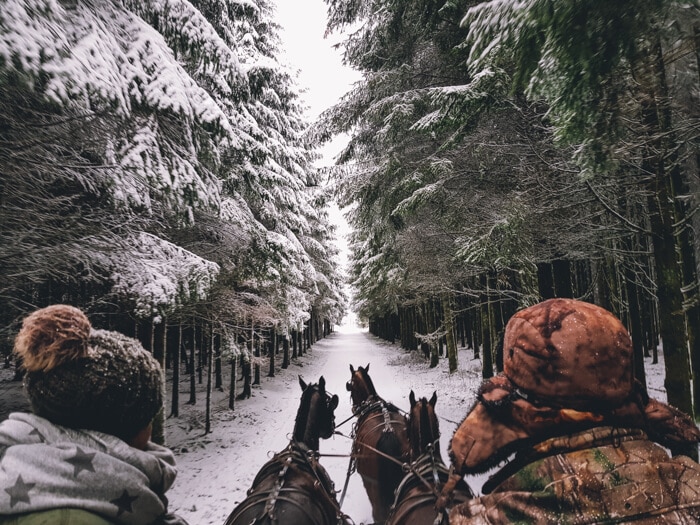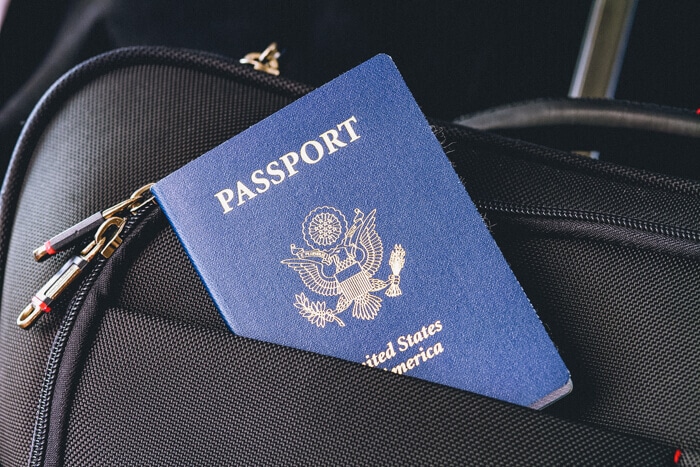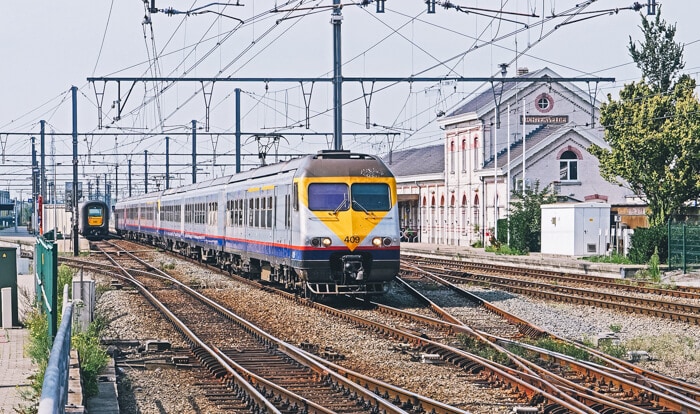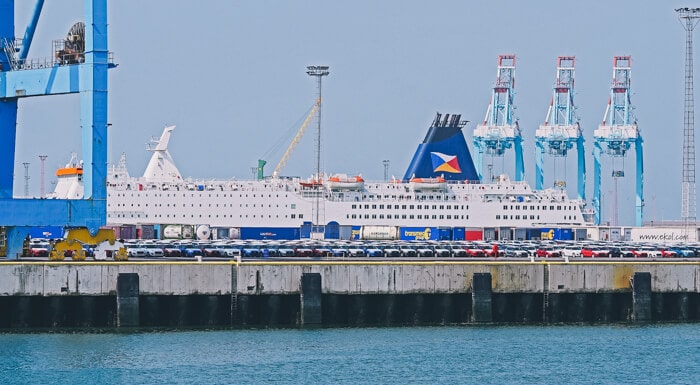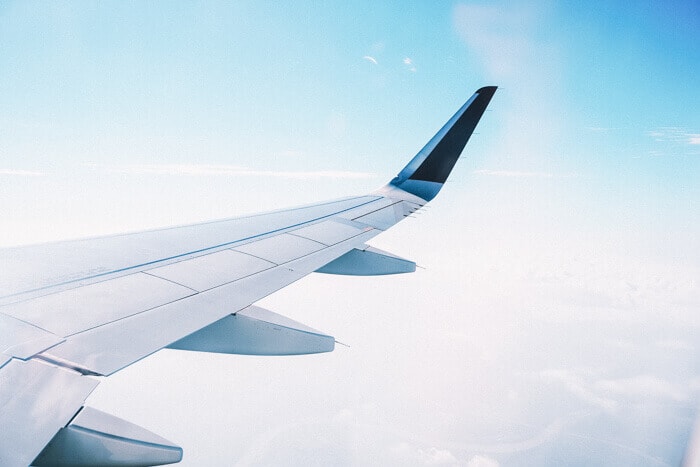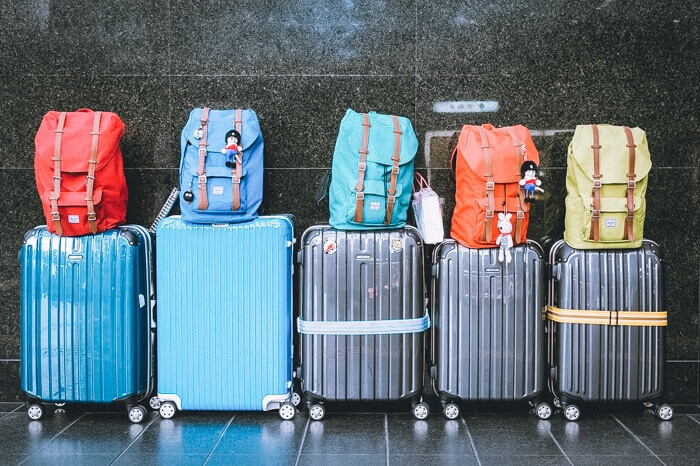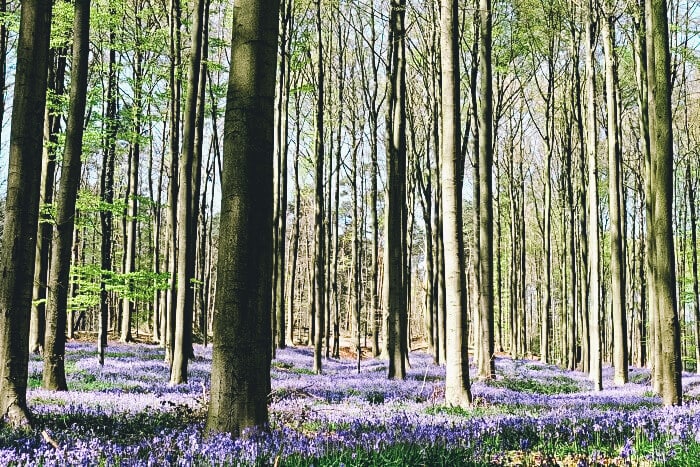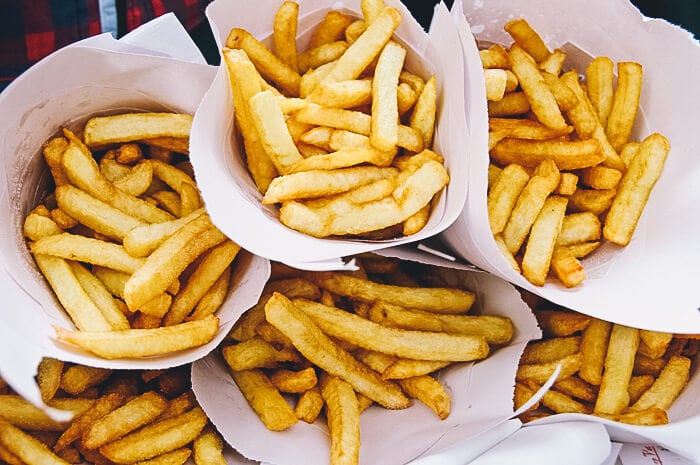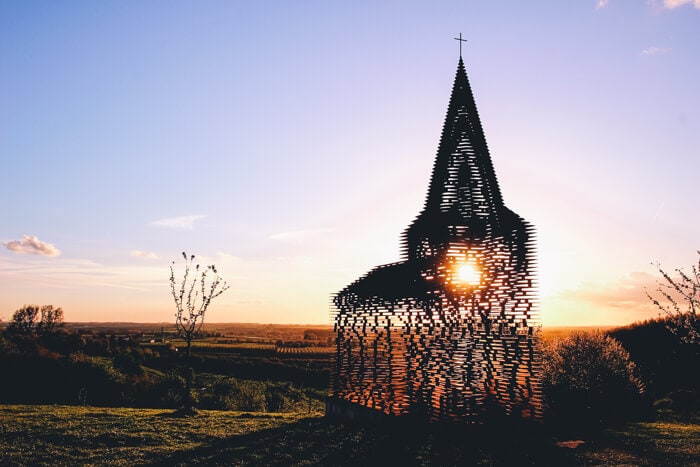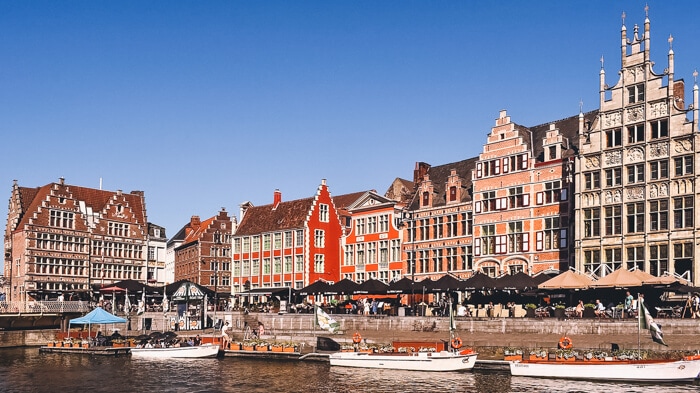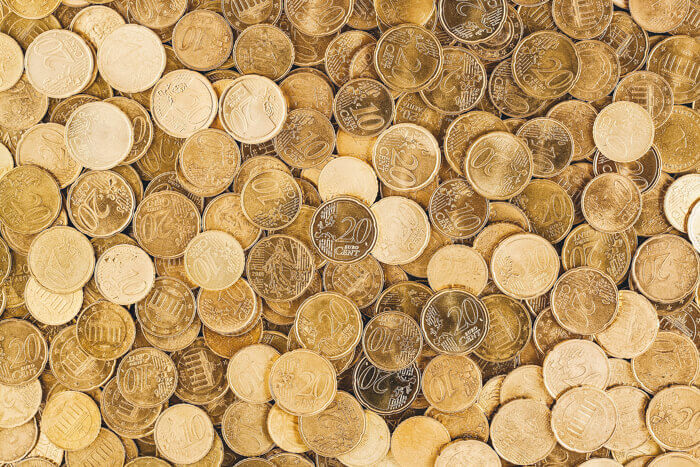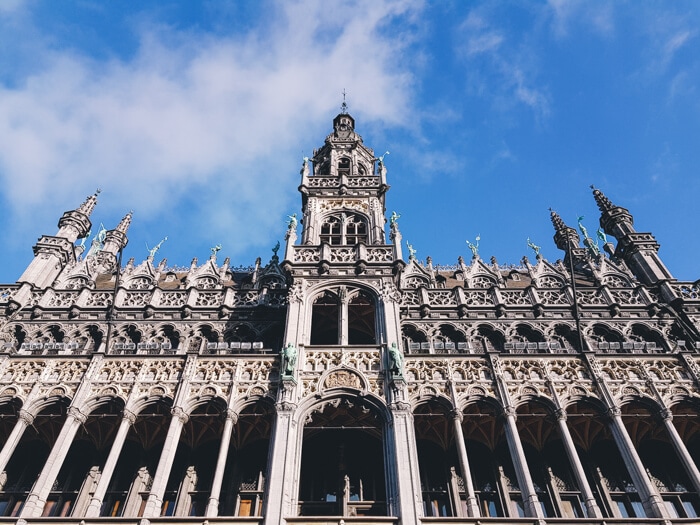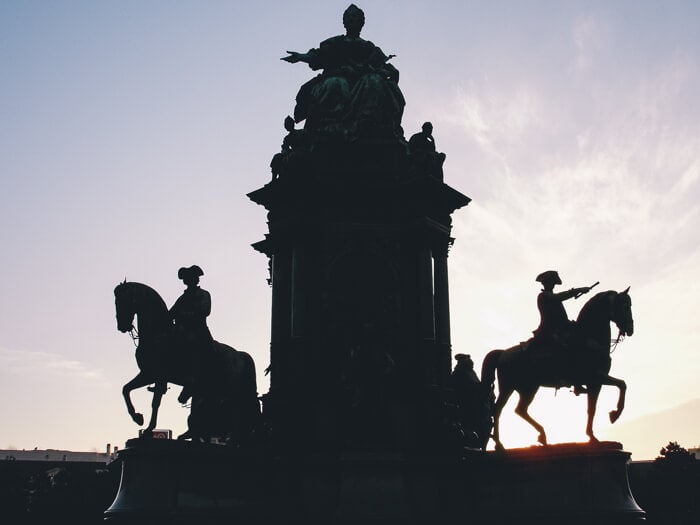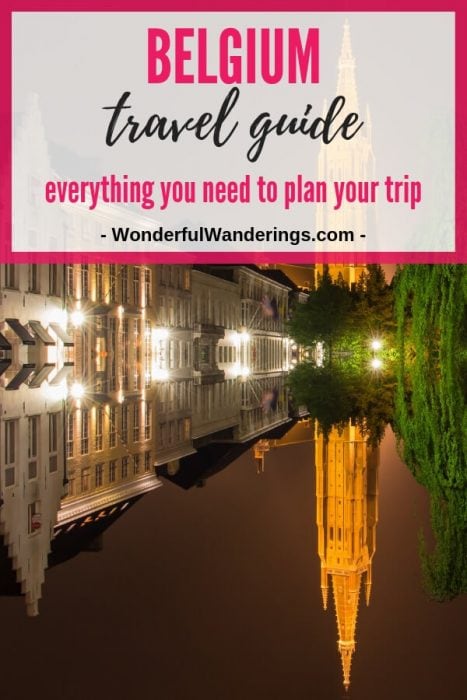Planning a trip to Belgium? Wonderful! Belgium, the land of chocolate, fries, and beer. Of Art Nouveau and the Flemish Primitives. That tiny country where the administrative center of the EU is located. My home country.
When people tell me they’ve been to Belgium, they’ve usually just been to Brussels and/or Bruges. Those are great places for sure but limiting yourself to these two cities would do the country injustice. There are castles in Belgium to be explored, trails to be walked, memorials to go silent for.
Let me show you some of the best places to visit in Belgium, some insider tips and give you all the information you need to plan your own Belgium vacation in this Belgium Travel Guide.
Contents
- Belgium travel guide: quick facts
- Belgian provinces and the capital of Brussels
- How to travel to Belgium
- How to travel around Belgium
- What to pack for Belgium
- The best time to visit Belgium
- What to eat in Belgium
- Belgium holidays
- Cultural things to be aware of in Belgium
- Where to stay in Belgium
- Don’t forget travel insurance
- Safety in Belgium
- The use of cash and cards in Belgium
- Staying connected while you travel Belgium
- Tipping in Belgium
- A brief history of Belgium
Belgium travel guide: quick facts
Size: it’s a small country at 30.528 km² or 11,787 sq mi
People living there: more than 11 million
Capital: Brussels
Governmental structure: federal constitutional monarchy with a parliamentary system
National day: July 21
Time zone: Central European Time / UTC+1 / GMT+1
Currency: euro (EUR)
Power voltage and socket type(s): 230V, plug types E and C. If these plug types don’t match your devices, make sure to bring a universal adapter to be able to charge them
Official religion(s)/Freedom of religion: Freedom of religion. 60% of the population is Roman Catholic, followed by atheist and agnostic citizens, other Christians, and Muslims.
Official language(s) and general knowledge of English: Dutch, French and German are the three official languages. English is widely spoken.
Drives on this side: right
International driver’s licence accepted? yes
Phone code: +32
Vaccinations needed? none mandatory.
Can you drink the tap water? yes, so make sure to bring your refillable water bottle
Want to know more interesting facts about Belgium? I have a whole post full of them.
Belgian provinces and the capital of Brussels
Belgium consists of 10 provinces and the district capital of Brussels. Before I tell you a bit more about each of them, watch the video below to try and understand the country’s complicated political and language structure.
It’s a bit crazy, I know. Luckily, if you’re just visiting Belgium, you don’t need to worry about any of this too much. What is good to know, is what you can find in each of the provinces and Brussels.
1. Brussels Capital-Region
As you’ve seen in the video above, the Belgian capital of Brussels and its many municipalities make up the Brussels Capital-Region. As is often the case with capitals, this is Belgium’s most diverse and cosmopolitan region. Not one neighborhood or municipality is like the other and if you truly want to get to know Brussels, you need to venture beyond the famous Grand Place and quirky Manneken Pis.
Brussels is its high art, medieval architecture, chocolate, and history, but it’s just as much its many local markets, bars with live music and people meeting up in parks for a picnic when the sun comes out. Of course, at the end of the year there are the Christmas markets.
Discover more of Brussels:
2. Antwerp
The province of Antwerp is named after the provincial capital city Antwerp which is internationally renowned as a fashion and art center. I’ve lived here for a year at the end of my studies and still happily go back. It’s one of those places where you can always discover something new and Antwerp is definitely one of my favorite cities in Belgium.
If you prefer a smaller city for a day trip, Mechelen is a good option and if you want to get moving, all you need to do is follow one of the province’s many walking or cycling routes.
Discover more of Antwerp:
3. East Flanders
In the province of East Flanders, the provincial capital Ghent is a fun destination for a weekend away. The university town combines a ton of history and beautiful buildings with cozy cafes and trendy boutiques. Check my post on things to do in Ghent for some inspiration.
Outside of Ghent, East Flanders is great for those who like to walk and bike. There are plenty of well-signed routes of varying lengths, oftentimes put together according to a theme. If you’re feeling a bit lazy, going on a riverboat tour is another option.
Discover more of East Flanders:
4. West Flanders
West Flanders is Belgium’s only coastal province. All the beaches in Belgium are part of it. It’s mostly known abroad for the provincial capital Bruges, with its UNESCO World Heritage city center, but is also a national tourism magnet. There’s a certain time of Belgian that, whenever the weather is even a bit nice, always flocks to the seaside at the north sea.
The coast isn’t just popular for its beaches. There are quite a few war memorial sites, from both World Wars, and the city of Ostend is home to several art galleries and museums. Whether you want to walk, bike, eat, shop, or brush up on your history, West Flanders has something for you.
Discover more of West Flanders:
5. Limburg
The province of Limburg is sometimes also called Belgian-Limburg to distinguish it from the Dutch province of Limburg. Its provincial capital is Hasselt, where you can visit places such as the National Jenever Museum and do quite a bit of shopping.
Limburg is home to the only national park of Belgium, the Hoge Kempen National Park, and counts several other natural areas that are great for hiking and walking.
It’s also a great place for those interested in industrial heritage. They can visit C-mine, a former mining complex turned into a cultural, entertainment, and small business center.
Discover more of Limburg:
6. Flemish Brabant
The province of Flemish Brabant circles all the way around Brussels and the provincial capital of Leuven, my hometown. It’s a densely populated province and yet it has a massive network of walking and cycling trails that take people through patches of forest, along pastures, and past rivers.
Museums for every possible interest keep you busy on a rainy day in between stops at local breweries, vineyards, and other producers.
Discover more of Flemish Brabant:
7. Brabant Wallon
While the capital of Brabant Wallon is Wavre, the historically most important city in the province is Waterloo, where Napoleon was defeated in 1815 and where you can now visit several museums as well as the battlefield grounds.
Aside from that, Brabant Wallon is also home to many parks and other outdoor recreational areas, the Hergé Museum – dedicated to the inventor of the comic character Tintin – and a collection of small museums mostly focusing on local life and history.
Discover more of Brabant Wallon:
8. Namur
The province of Namur is also known as the “Land of Valleys”, offering ample choice of walking, cycling, and equestrian routes as well as plenty of water activities. Local producers will gladly tell you more about their products after you’ve visited one of the many castles or other historical buildings in the region.
While the province is named after its capital city, Dinant is much better known. Small in size, its dominated by its citadel perched high upon a cliff overlooking the river Meuse.
9. Hainaut
Hainaut is home to more than 1,000 kilometers of signed walking and cycling routes as well as several places where you can try your hand at watersports. Book lovers can visit the Mundaneum – also called the “Paper Google” – while those interested in industrial heritage can choose between several former mining sites to visit, such as the site of Grand-Hornu.
The provincial capital of Mons was European Capital of Culture in 2015 and perfect for a day trip or a weekend away while Pairi Daiza is one of the most popular animal parks in Belgium.
10. Liège province
The province of Liège truly has a lot to offer. Part of the Ardennes, it’s a great choice for those who want to combine a good dose of nature with unpretentious local food, dozens of cultural heritage sites, even more museums and some (cross-country) skiing in winter or other outdoor activities in Belgium.
The capital city of Liège puts up the biggest Christmas market of the country and will easily keep you busy for a weekend while the town of Spa gave its name to spa centers around the world and is the perfect place to unwind.
Discover more of Liège province:
11.Belgian Luxembourg
The province of Belgian Luxembourg is also part of the Ardennes and known for its welcoming people, traditional terroir products, and both natural and cultural heritage. It’s where you come for some quiet time while walking, mountain biking or horseback riding on one of the many marked trails.
Make sure to check out the abbey of Orval, the castle of Bouillon, the smallest city in the world Durbuy, and the historically important Bastogne.
Want even more inspiration? Check out these fun things to do in Belgium.
How to travel to Belgium
Entry requirements
Belgium is part of the Schengen zone and so people from other Schengen countries can travel to it freely. People who live in EU countries outside of the Schengen zone may still enter freely but might need to show their ID or passport upon arrival.
Travelers from the United States and the rest of the world can generally visit Belgium for three months without a visa on the condition that their passports are valid up until six months after their stay.
How to get to Belgium
By bus
The most budget-friendly way to travel to Belgium is by bus from one of the other European countries. Flixbus is known for its great long-distance bus service and equally pleasant prices.
For more options, have a look at Omio. This platform automatically gives you the best route between two places and allows you to immediately book a ticket as well.
By train
It’s easy to travel to Belgium by train from the neighboring countries. The European website of the Belgian railroads, the NMBS, allows you to easily look up timetables and prices.
If you’re coming from the UK, you can also travel on the Eurostar from London to Brussels. It’s usually a bit faster than flying as you don’t need to be at the train station as early as you need to be at the airport and the Eurostar drops you off right in the center of Brussels.
Check Omio for timetables and prices
If you’re coming from France, Germany, or the Netherlands, the highspeed train Thalys is another fast way of getting to Belgium. It’s a bit pricier than a regular train but does offer more comfort and is faster too.
Look here for Thalys tickets
By ferry
There is currently only one ferry route to Belgium and it runs weekly between Hull in England and Zeebrugge. The journey can be made with P&O Ferries and takes about 13 hours and 15 minutes and.
Fly to Belgium
If you’re coming from a bit further away, the easiest way to travel to Belgium is by plane. Belgium’s main and most central airport is Brussels International. It welcomes flights from all over the world both by the “big” airlines and by budget airlines. It’s about 20 minutes by car or train from Brussels city center.
Brussels Charleroi is the airport they optimistically call Brussels South but it’s at least an hour’s drive from the capital. This is where mostly cheaper airlines arrive.
Antwerp and Ostend airport are two smaller airports which also welcome international flights but you’ll be most likely to fly to one of the other two.
For flights to Belgium, check Skyscanner. It gives a good overview of your options and their prices and also allows you to set flight alerts so you can track when those prices go up or down.
How to travel around Belgium
Independent travel around Belgium
The NMBS/SNCB trains provide the best option to move between cities and buses from De Lijn (in Flanders), the MIVB (in Brussels) and TEC (in Wallonia) will easily take you to smaller destinations.
Belgium is a small country and the highways are often congested. Renting a car isn’t recommended unless you plan on staying in a small village with hard access to public transport or unless you’re planning to road trip and then especially in the south of the country where there’s still more nature.
If you’re interested in getting a rental car for your trip to Belgium, check out AutoEurope.
Taxis are an option, but not really if you don’t want to spend a lot of money. A 15-minute drive can easily cost you €30.
What to pack for Belgium
Belgian weather can never be trusted, but the nicest time of the year is usually from June until September. In spring and autumn, it can be beautiful one day and then grey and rainy the next.
Winters can get a bit chilly, but it doesn’t often freeze during the day and it usually doesn’t snow for more than a week or two a year in total.
Just make sure to always pack an umbrella, whatever time of the year you decide to come.
What to pack for Belgium in summer
- sunscreen
- a reusable water bottle
- good walking sandals
- sneakers
- light clothing
- a rain jacket
- sunglasses
What to pack for Belgium in winter
- a warm wind and waterproof coat
- comfortable and warm shoes
- layers
- a merino woolen baselayer
- merino woolen socks
- gloves
- a reusable water bottle
- a warm scarf
- a hat
What to pack for Belgium in fall
I created an extensive packing list for Belgium in fall which you can find here.
What to pack for Belgium in spring
Both for fall and spring in Belgium, it’s important to pack layers. Some days can still/already be sunny and warm while others will be grey, wet, and cold. You probably won’t need a super warm winter coat but it is best to bring something warm and waterproof that you can easily stow away, like this jacket.
The best time to visit Belgium
As with all destinations, the best time to travel to Belgium depends a bit on what you’re looking for. If you want to visit the cities in Belgium and don’t mind a bit of cold or rain, anytime is good. If you’re looking for nice weather, I’d recommend anywhere between the second half of May and the end of September.
Summer is also festival time in Belgium with multiple festivals big and small taking place just about every weekend. Read more about summer trips to Belgium and some of the best Belgian music festivals.
Winter is the time of the Christmas markets and while not as known for them as Germany, for example, Belgium does have quite a few good ones. I’ve written more about Christmas markets in Belgium here.
Autumn is a bit of a more quiet time around the country but in spring, everyone is getting excited about the upcoming summer and there are several spring-related things to do, like visiting the purple flower forest, the flower show Floralia, or the rose garden Coloma.
What to eat in Belgium
Typical Belgian food is rather hearty and aside from a few classics like fries, you won’t find it that easily when going to a restaurant. That’s why I published this list of typical Belgian food to try and where you can find it in Brussels.
If you’d like to learn how to make some of these dishes yourself, check out this post with Belgian recipes.
Belgium holidays
When traveling somewhere, it’s always good to know whether there will be a special holiday during your stay. That’s why I’ve compiled a detailed list of holidays in Belgium which I update annually. It includes not only public holidays but also school holidays and other dates to take into account when planning your trip.
Cultural things to be aware of in Belgium
As you could see in the video, the language situation in Belgium is a bit complicated. It’s true that in some towns around the language barrier (and not even only there) people won’t be pleased if you use the “wrong” language, but in general Belgians are very flexible when it comes to speaking other languages and we’ll quickly switch to the other person’s language, especially when we notice that person is from out of the country.
If you speak French but not English and you’re visiting the Flemish side of Belgium, you can always ask whomever you’re talking to if it’s okay to speak French because you’re visiting and don’t speak Dutch or English, if you want to be absolutely sure not to offend anyone.
When it comes to socializing, there’s quite the difference between the northern and the southern part of the country. When I worked at the Belga Press Agency, my French speaking colleagues would give each other a kiss when arriving at the office, while my Flemish colleagues would shake hands. That about says it all.
Of course, this is a generalization, but I think you could say that the people from the south are a bit warmer and more open than the people from the northern part of Belgium. We all have cliques and groups we belong to and for an outsider, it’s not always easy to become part of such a group.
If you want to meet Belgians, I’d say the best approach is to just walk up to them because the chances of us walking up to a stranger are rather slim (again, generalizing here).
Where to stay in Belgium
Whenever I need to book a hotel somewhere, I always check Booking. com. I love that the site has so many filters you can use to easily get a list of just the places that fit your criteria. So if you’re looking for the best places to stay in Belgium, I highly recommend you do it there.
Don’t forget travel insurance
No matter how well you plan your trip to Belgium, there’s always something that can happen that’s beyond your control. Your luggage can get lost, you can get sick or you can drop and break that new camera. In all of these cases, good travel insurance has you covered.
I’ve had ongoing travel insurance ever since I started traveling by myself to make sure I’m covered for every trip I go on but if you travel just a few times a year, you can get insurance for each trip separately.
Don’t have travel insurance yet? Check out SafetyWing. They offer super flexible plans that you can even sign up for while you’re already on your trip. On top of that, they were the first travel insurance to cover COVID, and when I got COVID, they reimbursed all of my expenses without making a fuss. Their customer support team is great and I can personally recommend them.
Safety in Belgium
When people plan a trip to Brussels they often ask me “is Belgium safe?”. It’s as safe as the average capital anywhere in Europe, I’d say. There are pickpockets, robberies occur and once in a while a murder is committed. This all sounds really scary, but if you’re realistic, you know that it’s like that in any major city. Just watch your stuff and mind the neighborhoods you walk through at night.
As for the rest of Belgium, you just need to mind your belongings in busy areas but the risks of getting pickpocketed are rather low outside of the big cities. The only other thing that could be dangerous over here is getting into a car. We’re not the calmest drivers in the world and traffic can get a bit tense.
The use of cash and cards in Belgium
Belgians tend to use debit cards much more often than credit cards but you can pay with credit card in most stores and restaurants and at most service providers. It’s good to have some cash on you when you go to markets, shop at smaller boutiques or want to have a drink at a cafe.
There are ATMs, usually from multiple banks, in every town and city. Just make sure to check the fees your bank charges for withdrawing money abroad beforehand so you know whether it’s better to take out a big amount at once or not.
Staying connected while you travel Belgium
Traveling to Belgium from outside the EU and want to stay connected so you can share photos, call loved ones over WiFi and easily use apps like Google Maps? Then check out Solis Wifi mobile WiFi.
Skyroam offers both day passes and monthly subscriptions providing you with 4G throughout your trips. I’ve been using their daily passes not just when I travel outside the EU (no roaming charges for me in the EU) but also as a backup for when I think I’ll go over my phone’s data plan.
Check out Solis Wifi here.
Tipping in Belgium
Tipping isn’t mandatory in Belgium but as in many places, it is appreciated. All taxes and service are included in the bill and people working in the service industry make a living wage so it’s common to just round up the bill at places like cafes or small eateries and to add whatever you think is suitable at restaurants.
For more specific guidelines, check out this section on tipping on your Belgium trip.
A brief history of Belgium
What is now known as Belgium became part of the Roman empire in 57 B.C. and named “Belgica” by the Romans. It stayed that way until 5 A.D. when the Franks took over. They made their first capital the city of Tournai.
In the Middle Ages, Belgium was divided into smaller semi-independent regions such as counties and principalities which were under foreign rule, first by the French, then the Austrians, and then the Spanish. It knew a very brief period of independence in the 14th century after it defeated the French army following a rebellion.
After big European turmoils in the 17th century, Belgium became Austrian again at the beginning of the 18th century until the French annexed the country in 1795. Belgium stayed French until Napoleon was defeated at Waterloo in 1815 and it was merged together with the Netherlands.
The differences between the two were too big, though, and in 1830 a Belgian rebellion broke out that would lead to the official independence of the country in January 1831.
During the reign of the first king, Leopold I, Belgium continued the industrialization process that had started in the 19th century. The country knew a dark period with the rule of Leopold II, who made part of Africa, later known as Belgian Congo, his personal property and committed atrocities against the natives who he exploited mostly for harvesting rubber.
The Belgian Congo became state property in 1908, a year before Leopold II died and would remain a colony until 1960.
Later in the 20th century, Belgium suffered a great deal both during World War I and World War II when it was occupied by the Germans twice. It managed to recover quite well and became one of the founding members of the European Union and of NATO.
And that’s it! I hope this guide to Belgium has given you an idea of what to do in Belgium and will help you plan your own trip here.
Find below the important posts about Belgium.
PIN FOR LATER
My Belgium travel guide contains affiliate links. If you book or buy something through these links, I earn a small commission at no extra cost to you.

